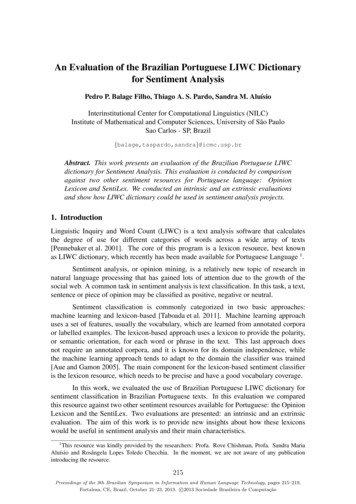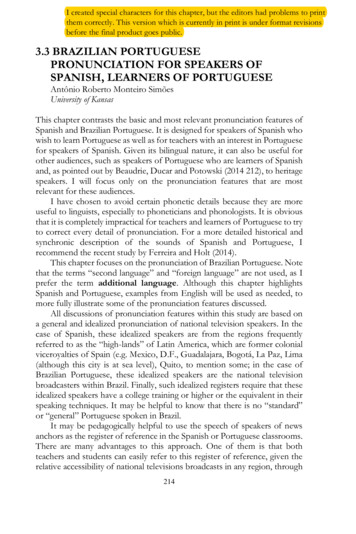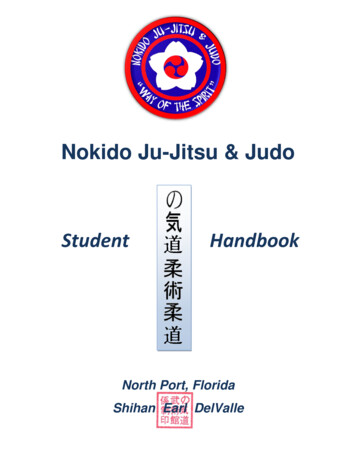
Transcription
An Evaluation of the Brazilian Portuguese LIWC Dictionaryfor Sentiment AnalysisPedro P. Balage Filho, Thiago A. S. Pardo, Sandra M. Aluı́sioInterinstitutional Center for Computational Linguistics (NILC)Institute of Mathematical and Computer Sciences, University of São PauloSao Carlos - SP, . This work presents an evaluation of the Brazilian Portuguese LIWCdictionary for Sentiment Analysis. This evaluation is conducted by comparisonagainst two other sentiment resources for Portuguese language: OpinionLexicon and SentiLex. We conducted an intrinsic and an extrinsic evaluationsand show how LIWC dictionary could be used in sentiment analysis projects.1. IntroductionLinguistic Inquiry and Word Count (LIWC) is a text analysis software that calculatesthe degree of use for different categories of words across a wide array of texts[Pennebaker et al. 2001]. The core of this program is a lexicon resource, best knownas LIWC dictionary, which recently has been made available for Portuguese Language 1 .Sentiment analysis, or opinion mining, is a relatively new topic of research innatural language processing that has gained lots of attention due to the growth of thesocial web. A common task in sentiment analysis is text classification. In this task, a text,sentence or piece of opinion may be classified as positive, negative or neutral.Sentiment classification is commonly categorized in two basic approaches:machine learning and lexicon-based [Taboada et al. 2011]. Machine learning approachuses a set of features, usually the vocabulary, which are learned from annotated corporaor labelled examples. The lexicon-based approach uses a lexicon to provide the polarity,or semantic orientation, for each word or phrase in the text. This last approach doesnot require an annotated corpora, and it is known for its domain independence, whilethe machine learning approach tends to adapt to the domain the classifier was trained[Aue and Gamon 2005]. The main component for the lexicon-based sentiment classifieris the lexicon resource, which needs to be precise and have a good vocabulary coverage.In this work, we evaluated the use of Brazilian Portuguese LIWC dictionary forsentiment classification in Brazilian Portuguese texts. In this evaluation we comparedthis resource against two other sentiment resources available for Portuguese: the OpinionLexicon and the SentiLex. Two evaluations are presented: an intrinsic and an extrinsicevaluation. The aim of this work is to provide new insights about how these lexiconswould be useful in sentiment analysis and their main characteristics.1This resource was kindly provided by the researchers: Profa. Rove Chishman, Profa. Sandra MariaAluı́sio and Rosângela Lopes Toledo Checchia. In the moment, we are not aware of any publicationintroducing the resource.215Proceedings of the 9th Brazilian Symposium in Information and Human Language Technology, pages 215–219,Fortaleza, CE, Brazil, October 21–23, 2013. c 2013 Sociedade Brasileira de Computação
2. Sentiment Lexicons2.1. LIWC DictionaryThe LIWC dictionary is a recent lexicon which was built from the original English LIWCdictionary [Pennebaker et al. 2001]. The purpose of this lexicon is to group words intocategories that can further be used to analyze psycho-linguistic features in texts.The LIWC dictionary has 127,149 entries, where each entry can be assigned toone or more categories. The two categories used in this evaluation are posemo (12,878entries), which stands for positive emotion, and negemo (15,115 entries), which standsfor negative emotion. Other categories would also be useful (e.g., affect, anger, sad, etc),however, we decided it would be a fair comparison against the other lexicons if we usedonly these two.The English version for LIWC dictionary has been used for a number of relevantworks in sentiment analysis. For example, SentiStrength [Thelwall et al. 2010] usesLIWC dictionary for building its internal word list, which is the core of this sentimentclassifier; Ott et al. [Ott et al. 2011] uses it to identify fictitious opinions that have beendeliberately written to sound authentic; Kim et al. [Kim et al. 2012] uses it to classifyanonymous texts.2.2. OpinionLexiconThe OpinionLexicon [Souza et al. 2011] is a dictionary built for sentiment analysis task.To construct this resource, the authors applied three methods from the literature: a corpusbased, a thesaurus-based and an automatic translation system. The lexicon in the version2.1 is composed of 30,678 entries (30,236 words and 442 phrases).Opinion Lexicon was used by Souza and Vieira [Souza and Vieira 2012] fortwitter sentiment analysis; and by Ribeiro Junior et al. [Ribeiro Junior et al. 2012] toassess vehicle features in blogs.2.3. SentiLexSentiLex [Silva et al. 2012] is a lexicon constructed for social judgments domain. Thelexicon approach was built starting from publicly available language resources andenlarged by a combination of a linguistic-based and machine learning strategies.The SentiLex (version 2) is made up of 82,347 inflected forms, organized inadjectives (16,863), nouns (1,280), verbs (29,504) and idiomatic expressions (34,700).SentiLex was used by Morgado [Morgado 2012] in sentiment classification for Portuguese On-line news and by Santos et al. [Santos et al. 2012] to evaluate positive andnegative polarity propagation of words.3. Agreement EvaluationFirst, in order to conduct a fair evaluation, we normalized all lexicons into a comparableformat. In this normalization, we only took the unigrams and their polarity. For entriescontaining more than one polarity, we choose the polarity for the first entry. Thisassumption was made in order to have a comparable format among the dictionaries(because LWIC does not have PoS or semantic roles). As LIWC dictionary has not aneutral category, we conducted the comparison against polar words only.216
In our experiment, we analyzed the pairwise agreement, i.e., number of lexiconentries with equal polarity, among the lexicons. Table 1 shows this agreement.Table 1. Lexical Agreement for polar entriesAgreementLIWCOpinion LexiconLIWCx80.17% (of 1,871 entries)Opinion LexiconxxSentiLexxxSentiLex74.83% (of 7,310 entries)97.04% (of 13,880 entries)xAs we can see from Table 1, LIWC stands for 80% of agreement with OpinionLexicon and 75% with SentiLex. The correlation between Opinion Lexicon and SentiLexis 97%. The next section shows an extrinsic evaluation based on a sentiment analysis task.4. Sentiment ClassificationThe purpose of an extrinsic evaluation is to measure the performance of each lexicon inthe sentiment classification task. For this reason, we choose to perform a simple lexiconbased sentiment classification where the lexicon performs almost all the work.The algorithm adopted for this task is similar to the SO-CAL described in[Taboada et al. 2011]. This algorithm computes the individual polarity for each wordin the lexicon and then sums up all these polarities to form the text polarity. If the sumis zero, the text is classified as neutral; if it is greater than zero, the text is classified aspositive; otherwise, negative. The SO-CAL also accounts for intensification, irrealis andnegation in the text.There are few corpora available for sentiment classification in Portugueselanguage. For conducting this evaluation, we choose the ReLi [Freitas et al. 2012], acorpus from a Brazilian social network of book reviews. We choose this corpus because itis relatively new and we are not aware of any work that uses it yet, so we took the chanceto understand better this resource. In addition, we also believed this corpus would notbias any of the lexicons in the evaluation.The corpus is composed by 2,056 reviews from 13 different books (approximately200 reviews each). The corpus has 300,000 words and 15,000 sentences that wereannotated with PoS and chunks. The sentiment annotation is present in the opinion andsentence levels. The corpus has 4,210 positive opinion spans and 1,024 negative opinionspans. In the level of sentence, the corpus has 2,883 positive sentences and 596 negativeones.For the evaluation, we choose to use both opinion and sentence levels of sentimentannotation. Therefore, we conduct two main experiments: opinion classification andsentence classification. The opinions present in the corpus are either positive or negative.Despite this factor, we did not change our lexicon classifier, so the classifier output couldbe positive, negative or neutral. Table 2 shows the results for the opinion classificationin terms of precision, recall, F-measure and accuracy, which are common metrics for textclassification evaluation. We omit the results for the neutral class.As we can see from Table 2, all systems had a similar accuracy for opinionclassification. When we compare the individual classes, the LIWC Lexicon had a217
Table 2. Results for Opinion tiveOpinion ter performance in positive texts (F-measure of 70.37%) while SentiLex had a betterperformance in negative texts (F-measure of 60.25%).Our second experiment was to perform sentence classification. Table 3 shows theresults.Table 3. Results for Sentence tiveOpinion 49%34.06%58.74%47.28%Accuracy57.33%47.42%44.17%As we can see in Table 3, LIWC continues to have difficult to label negativeexamples (F-measure of 28.95%), but it have a high score for positive class (F-measureof 74.48%). By these results, we may assume that LIWC dictionary performs betterindicating positivity than negativity.5. Final ConclusionsIn this paper, we presented an evaluation for the Brazilian Portuguese LIWC dictionary.This evaluation aims to guide future works in lexicon-based sentiment analysis. Weconducted two evaluations: an intrinsic evaluation, by measuring the agreement comparedwith two other lexicons; and an extrinsic evaluation, by measuring the lexicon impact ina sentiment classification task.AcknowledgementsWe would like to thank the effort of those who produced the lexicons and the corpus usedin this evaluation. We also would like to thank FAPESP and CNPq for financial support.ReferencesAue, A. and Gamon, M. (2005). Customizing sentiment classifiers to new domains:A case study. In Proceedings of recent advances in natural language processing(RANLP), volume 1, pages 2–1.218
Freitas, C., Motta, E., Milidiú, R., and Cesar, J. (2012). Vampiro que brilha. rá! Desafiosna anotação de opinião em um corpus de resenhas de livros. In Proceedings do XIEncontro de Linguı́stica de Corpus (XI ELC), São Carlos - SP.Kim, I. J., Yoon, J. Y., Lim, J. Y., Kim, S. K., and Kim, U. M. (2012). Integrationof opinion mining service flow with anonymous information. In Proceedingsof the 6th International Conference on Ubiquitous Information Management andCommunication, ICUIMC ’12, pages 104:1–104:4, New York, NY, USA. ACM.Morgado, I. C. (2012). Classification of sentiment polarity of portuguese on-line news. InProceedings of the 7th Doctoral Symposium in Informatics Engineering, pages 139–150.Ott, M., Choi, Y., Cardie, C., and Hancock, J. T. (2011). Finding deceptive opinion spamby any stretch of the imagination. In Proceedings of the 49th Annual Meeting of theAssociation for Computational Linguistics: Human Language Technologies - Volume1, HLT ’11, pages 309–319, Stroudsburg, PA, USA. Association for ComputationalLinguistics.Pennebaker, J. W., Francis, M. E., and Booth, R. J. (2001). Linguistic inquiry and wordcount: Liwc 2001. Mahway: Lawrence Erlbaum Associates.Ribeiro Junior, S. S., Junior, Z., Meira Junior, W., and Pappa, G. L. (2012). Positive ornegative ? Using blogs to assess vehicles features. In Proceedings of the IX Encontrode Inteligência Artificial (ENIA), Curitiba-PR, Brazil.Santos, A., Oliveira, H., Ramos, C., and Marques, N. (2012). The role of languageregisters in polarity propagation. In Caseli, H., Villavicencio, A., Teixeira, A.,and Perdigão, F., editors, Computational Processing of the Portuguese Language,volume 7243 of Lecture Notes in Computer Science, pages 235–240. Springer BerlinHeidelberg.Silva, M. J., Carvalho, P., and Sarmento, L. (2012). Building a Sentiment Lexicon forSocial Judgement Mining. Computational Processing of the Portuguese Language,pages 218–228.Souza, M. and Vieira, R. (2012). Sentiment Analysis on Twitter Data for PortugueseLanguage. Computational Processing of the Portuguese Language, 7243:241–247.Souza, M., Vieira, R., Chishman, R., and Alves, I. M. (2011). Construction of aPortuguese Opinion Lexicon from multiple resources. In 8th Brazilian Symposiumin Information and Human Language Technology - STIL, Mato Grosso, Brazil.Taboada, M., Brooke, J., Tofiloski, M., Voll, K., and Stede, M. (2011). Lexicon-BasedMethods for Sentiment Analysis. Computational Linguistics, 37(2):267–307.Thelwall, M., Buckley, K., Paltoglou, G., Cai, D., and Kappas, A. (2010). Sentimentstrength detection in short informal text. Journal of the American Society forInformation Science and Technology, 61(12):2544–2558.219
There are few corpora available for sentiment classification in Portuguese language. For conducting this evaluation, we choose the ReLi [Freitas et al. 2012], a corpus from a Brazilian social network of book reviews. We choose this corpus because it is relatively new and we are not aware of any work that uses it yet, so we took the chance


![Encyclopedia of Brazilian Jiu Jitsu: Volume 2 [Pdf] - Rigan Machado (2022)](/img/62/encyclopedia-20of-20brazilian-20jiu-20jitsu-20volume-202-20pdf.jpg)







